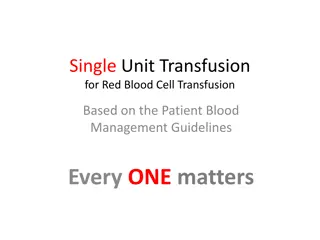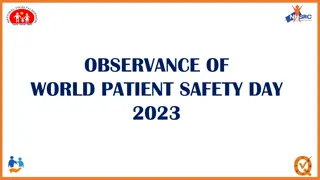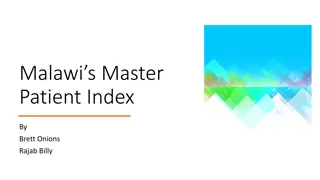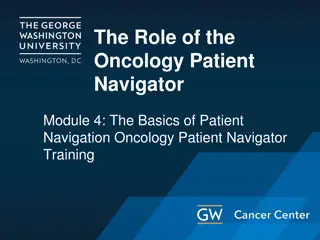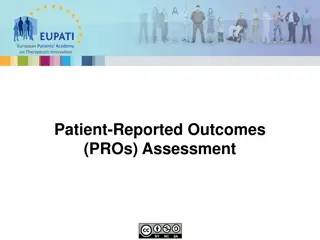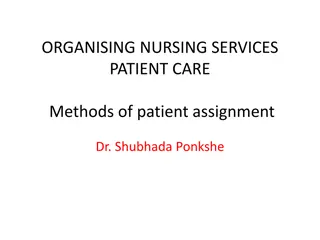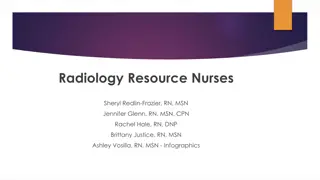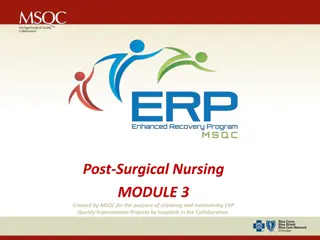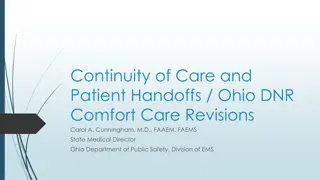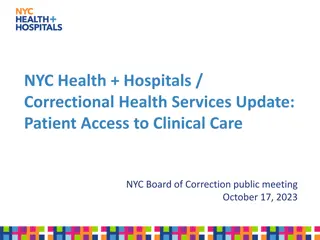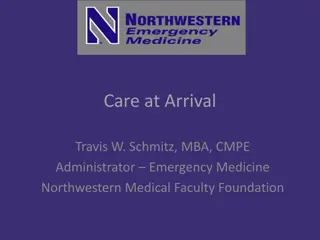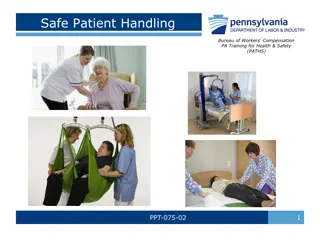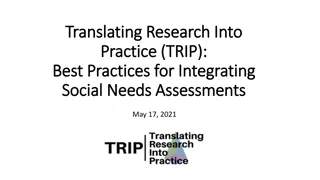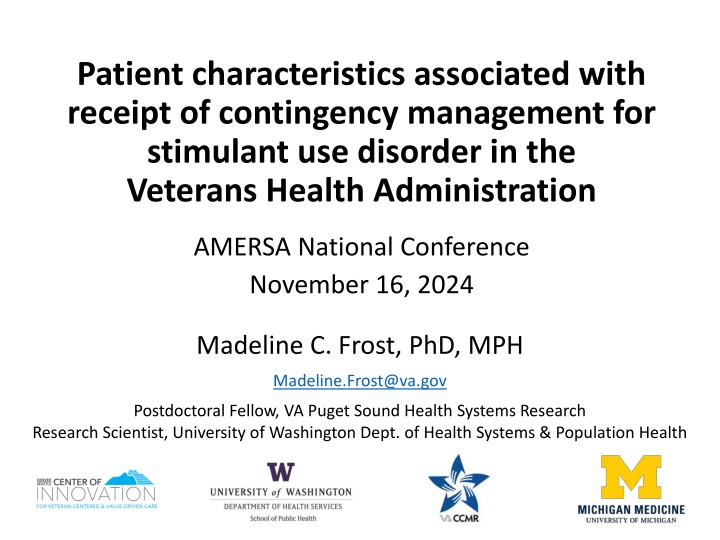
Characteristics Associated with Contingency Management for Stimulant Use Disorder in Veterans Health Administration
This research study explores patient characteristics associated with the receipt of contingency management for stimulant use disorder within the Veterans Health Administration. The study emphasizes the increasing prevalence of stimulant use disorder in the U.S. and the effectiveness of contingency management as a treatment approach. Collaborating with various experts, the authors shed light on the urgency and significance of addressing stimulant-related harms through evidence-based interventions. The study is supported by the VA Office of Mental Health and Suicide Prevention, showcasing a commitment to enhancing care for individuals with substance use disorders.
Download Presentation

Please find below an Image/Link to download the presentation.
The content on the website is provided AS IS for your information and personal use only. It may not be sold, licensed, or shared on other websites without obtaining consent from the author. If you encounter any issues during the download, it is possible that the publisher has removed the file from their server.
You are allowed to download the files provided on this website for personal or commercial use, subject to the condition that they are used lawfully. All files are the property of their respective owners.
The content on the website is provided AS IS for your information and personal use only. It may not be sold, licensed, or shared on other websites without obtaining consent from the author.
E N D
Presentation Transcript
Patient characteristics associated with receipt of contingency management for stimulant use disorder in the Veterans Health Administration AMERSA National Conference November 16, 2024 Madeline C. Frost, PhD, MPH Madeline.Frost@va.gov Postdoctoral Fellow, VA Puget Sound Health Systems Research Research Scientist, University of Washington Dept. of Health Systems & Population Health
Co-authors Lara N. Coughlin, PhD Michigan Innovations in Addiction Care through Research & Education (MI- ACRE), Addiction Center, Department of Psychiatry, University of Michigan Lan Zhang, PhD VA Center for Clinical Management Research (CCMR), VA Ann Arbor Healthcare System Michigan Innovations in Addiction Care through Research & Education (MI- ACRE), Addiction Center, Department of Psychiatry, University of Michigan Devin C. Tomlinson, PhD Michigan Innovations in Addiction Care through Research & Education (MI- ACRE), Addiction Center, Department of Psychiatry, University of Michigan Lewei (Allison) Lin, MD, MS VA Center for Clinical Management Research (CCMR), VA Ann Arbor Healthcare System Michigan Innovations in Addiction Care through Research & Education (MI- ACRE), Addiction Center, Department of Psychiatry, University of Michigan
Acknowledgments Support: VA Office of Mental Health and Suicide Prevention VA Advanced Fellowship Program in HSR, Office of Academic Affiliations, US Department of Veterans Affairs Disclosures: Dr. Lin consults on telehealth for substance use disorder treatment for Providers Clinical Support System with funding from the Substance Abuse and Mental Health Services Administration, and for National Center for Quality Assurance with funding from Alkermes. No other disclosures are reported. Disclaimer: The opinions expressed in this work are the authors and do not necessarily reflect those of the Department of Veterans Affairs or the United States Government.
Background Stimulant use disorder (StUD) and stimulant-related harms have increased substantially in the U.S. In 2023, over 4.3 million U.S. residents had StUD. --From 2015 to 2022, there was almost a five- fold increase in stimulant- involved overdose deaths. Sources: SAMHSA, 2023, NSDUH Detailed Tables; NIDA, 2024, Drug Overdose Deaths: Facts and Figures
Background Contingency management (CM) is currently the most effective treatment for StUD. No FDA-approved treatment medications (research is ongoing) CM is recommended as first-line treatment for StUD CM is a psychosocial therapy that involves reinforcing abstinence from substances (or other health- promoting behaviors) with financial or other incentives. Sources: UpToDate, 2024, Stimulant use disorder: Treatment overview; HHS, 2023, Contingency Management for the Treatment of Substance Use Disorders; thenounproject.com
Background Implementation of CM in healthcare settings has been very limited. There are several barriers to implementation, such as policy, financial and logistical barriers and stigmatized views of CM. Expanding CM provision is needed to address the rising impact of stimulants. Sources: HHS, 2023, Contingency Management for the Treatment of Substance Use Disorders
Background In 2011, the Veterans Health Administration (VHA) rolled out the largest ever implementation of CM. The rollout had strong uptake and high fidelity to their CM model However, CM provision was reduced during the COVID-19 pandemic and has not returned to pre-pandemic levels Most VHA patients with StUD still do not receive CM Sources: DePhilippis et al., 2018, DAD; Coughlin et al., 2024, JSAT
Objective To inform efforts to increase CM provision, it is important to understand which patient characteristics are associated with CM receipt. To our knowledge, no prior studies have examined this in the VHA or in other healthcare settings. Among national VHA patients with StUD, we compared characteristics between those who did and did not receive CM. Sources: thenounproject.com
Data Source and Sample Data Source: National VHA electronic health record (EHR) Study period: FY2021-FY2022 (10/1/20-9/30/22) Sample inclusion criteria: 1 visit during the study period in 81 VHA facilities that had implemented CM. StUD diagnosis (cocaine and/or amphetamine/other stimulant) in the year prior to the patient s first visit during the study period (index visit).
Measures Outcome: Receipt of CM for StUD, defined as 1 visit with CM template with a linked StUD diagnosis in the year following the patient s first visit during the study period (index visit).
Measures Patient characteristics (measured based on EHR documentation at time of or in year prior to index visit): Sociodemographic (age, sex, race, ethnicity, rurality, VA eligibility status, housing instability) Clinical (other substance use disorders, mental health disorders, Elixhauser comorbidity index) Utilization (number of past-year StUD psychotherapy visits and past-year StUD medication management visits, not including CM visits)
Analyses Described sample characteristics and overall CM receipt Logistic regression to examine which patient characteristics were associated with CM receipt Generalized estimating equation (GEE) model to account for clustering by VHA facility
Results Characteristics of sample (N=93,960): Mean age was 55 years (SD: 13.2) 93% male, 7% female 49% White, 42% Black, 2% Asian or Pacific Islander, 1% American Indian or Alaska Native, 7% Hispanic ethnicity 90% urban residence 50% had 50-100% VHA service connection status (indicates service-connected disability/increased eligibility for VHA services) 40% experiencing homelessness/housing instability
Results Characteristics of sample (N=93,960): 21% had opioid use disorder 56% had alcohol use disorder 18% had cannabis use disorder 21% had another drug use disorder 50% had tobacco use disorder 51% had depression 40% had PTSD 33% had anxiety 27% had serious mental illness (bipolar, psychosis, and/or schizophrenia) 67% had 3 Elixhauser comorbidities
Results Characteristics of sample (N=93,960): Mean number of past-year StUD psychotherapy visits was 3.5 (SD: 13.6) Mean number of past-year StUD medication management visits was 1.0 (SD: 2.5)
Results Only 1.2% (n=1,113) of the sample received CM.
Results Characteristic aOR 95% CI Age (ref: 18-29) 30-44 45-64 65 1.94 2.11 1.27 1.15-3.28 1.25-3.56 0.74-2.19 Male (ref: female) 0.98 0.78-1.23 Race (ref: White) Black Asian/Pacific Islander American Indian/Alaska Native Unknown 1.51 1.28 0.79 1.19 1.29-1.75 0.79-2.06 0.35-1.80 0.93-1.52 Hispanic ethnicity 1.31 1.00-1.72 Rural (ref: urban) 0.66 0.50-0.87 VA eligibility (ref: non-service connected) Service connection <50% Service connection 50-100% Other/unknown 1.27 1.36 1.11 1.06-1.52 1.16-1.60 0.52-2.39 Housing instability 1.68 1.48-1.92 **Note: results are from single model; patient characteristics across all slides are included
Results Characteristic aOR 95% CI Age (ref: 18-29) 30-44 45-64 65 1.94 2.11 1.27 1.15-3.28 1.25-3.56 0.74-2.19 Male (ref: female) 0.98 0.78-1.23 Race (ref: White) Black Asian/Pacific Islander American Indian/Alaska Native Unknown 1.51 1.28 0.79 1.19 1.29-1.75 0.79-2.06 0.35-1.80 0.93-1.52 Hispanic ethnicity 1.31 1.00-1.72 Rural (ref: urban) 0.66 0.50-0.87 VA eligibility (ref: non-service connected) Service connection <50% Service connection 50-100% Other/unknown 1.27 1.36 1.11 1.06-1.52 1.16-1.60 0.52-2.39 Housing instability 1.68 1.48-1.92 **Note: results are from single model; patient characteristics across all slides are included
Results Characteristic aOR 95% CI Age (ref: 18-29) 30-44 45-64 65 1.94 2.11 1.27 1.15-3.28 1.25-3.56 0.74-2.19 Male (ref: female) 0.98 0.78-1.23 Race (ref: White) Black Asian/Pacific Islander American Indian/Alaska Native Unknown 1.51 1.28 0.79 1.19 1.29-1.75 0.79-2.06 0.35-1.80 0.93-1.52 Hispanic ethnicity 1.31 1.00-1.72 Rural (ref: urban) 0.66 0.50-0.87 VA eligibility (ref: non-service connected) Service connection <50% Service connection 50-100% Other/unknown 1.27 1.36 1.11 1.06-1.52 1.16-1.60 0.52-2.39 Housing instability 1.68 1.48-1.92 **Note: results are from single model; patient characteristics across all slides are included
Results Characteristic aOR 95% CI Opioid use disorder 1.22 1.05-1.42 Alcohol use disorder 1.23 1.07-1.42 Cannabis use disorder 1.01 0.86-1.18 Other drug use disorder 1.33 1.15-1.55 Tobacco use disorder 0.88 0.77-1.00 Depression 1.08 0.94-1.24 PTSD 0.85 0.74-0.98 Anxiety 0.86 0.75-1.00 Serious mental illness 0.88 0.76-1.02 3 Elixhauser comorbidities 0.73 0.62-0.86 Number of past-year StUD psychotherapy visits 1.01 1.01-1.01 Number of past-year StUD medication management visits 1.05 1.03-1.07 **Note: results are from single model; patient characteristics across all slides are included
Results Characteristic aOR 95% CI Opioid use disorder 1.22 1.05-1.42 Alcohol use disorder 1.23 1.07-1.42 Cannabis use disorder 1.01 0.86-1.18 Other drug use disorder 1.33 1.15-1.55 Tobacco use disorder 0.88 0.77-1.00 Depression 1.08 0.94-1.24 PTSD 0.85 0.74-0.98 Anxiety 0.86 0.75-1.00 Serious mental illness 0.88 0.76-1.02 3 Elixhauser comorbidities 0.73 0.62-0.86 Number of past-year StUD psychotherapy visits 1.01 1.01-1.01 Number of past-year StUD medication management visits 1.05 1.03-1.07 **Note: results are from single model; patient characteristics across all slides are included
Results Characteristic aOR 95% CI Opioid use disorder 1.22 1.05-1.42 Alcohol use disorder 1.23 1.07-1.42 Cannabis use disorder 1.01 0.86-1.18 Other drug use disorder 1.33 1.15-1.55 Tobacco use disorder 0.88 0.77-1.00 Depression 1.08 0.94-1.24 PTSD 0.85 0.74-0.98 Anxiety 0.86 0.75-1.00 Serious mental illness 0.88 0.76-1.02 3 Elixhauser comorbidities 0.73 0.62-0.86 Number of past-year StUD psychotherapy visits 1.01 1.01-1.01 Number of past-year StUD medication management visits 1.05 1.03-1.07 **Note: results are from single model; patient characteristics across all slides are included
Discussion Large majority of VHA patients with StUD are not receiving CM, even in facilities that have implemented CM. CM may be more likely to reach certain groups of patients that have historically faced disparities for other SUD treatment, including Black patients and those experiencing housing instability Exception is rural patients who were less likely to receive CM
Discussion Patients with co-occurring opioid, alcohol or other drug use disorders may be more likely to receive CM However, patients with PTSD or a larger overall comorbidity burden may be less likely to receive CM Patients with more prior psychotherapy or medication management visits for StUD may be more likely to receive CM, suggesting that CM may be provided after trying other treatments.
Implications/Next Steps Ongoing efforts are needed to increase provision of CM in VHA. Consider access for rural patients (e.g., supporting telehealth delivery of CM) Further research is needed to understand what specific barriers need to be addressed, as well as why certain groups of patients may be less likely to receive CM.
Limitations Exploratory study (not testing pre-specified hypothesis) EHR documentation of CM receipt and patient characteristics may have inaccuracies No measures of sexual orientation and gender identity Results may not be generalizable outside of the VHA
Thank you! Madeline Frost, PhD, MPH Madeline.Frost@va.gov Postdoctoral Fellow, VA Puget Sound Health Systems Research Research Scientist, University of Washington Dept. of Health Systems & Population Health


